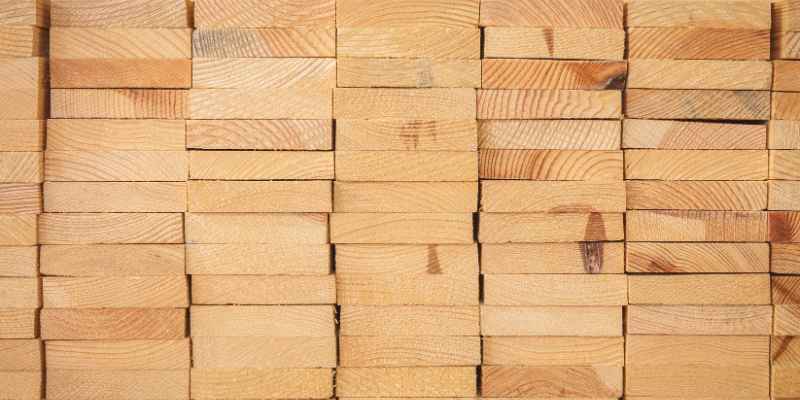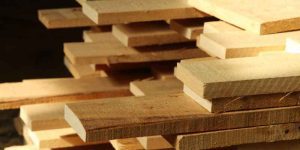4/4 wood refers to lumber that is four-quarters of an inch thick, which is equivalent to one inch in thickness. This measurement is commonly used in the woodworking industry for various projects such as furniture, cabinetry, and flooring.
Woodworkers and builders often use 4/4 wood as it is readily available, easy to work with, and can be sourced from a variety of tree species. The thickness of the wood allows for stability and strength, making it suitable for a range of applications.
Additionally, 4/4 wood is often sold in rough-sawn form, allowing woodworkers to mill it to their desired dimensions. This flexibility makes it a popular choice for both professional and amateur woodworkers alike.
Decoding Lumber Jargon
Unraveling lumber terminology, 4/4 wood refers to wood that is 1 inch thick before being processed.
If you’re new to woodworking, the terms and measurements used in the lumber industry can be confusing. One of the most common jargon you’ll hear is the term “4/4 wood”. This refers to the thickness of a board, and it’s important to understand it if you’re planning to purchase lumber for your projects.
The Basics Of Board Footage
Before we dive into the 4/4 code, it’s important to understand the concept of board footage. Board footage is the unit of measurement used in the lumber industry to determine the volume of wood in a board. One board foot is equal to a piece of wood that measures one foot in length, one foot in width, and one inch in thickness.
Unraveling The 4/4 Code
Now that you understand board footage, let’s talk about the 4/4 code. This code is used to describe the thickness of a board and is based on fractions of an inch. In the case of 4/4 wood, the board is 1 inch thick, but the fraction is still used to describe it.
Here’s a breakdown of the most common lumber thicknesses and their corresponding codes:
- 4/4 – 1 inch thick
- 5/4 – 1.25 inches thick
- 6/4 – 1.5 inches thick
- 8/4 – 2 inches thick
So, if you’re looking for a board that is 1 inch thick, you’ll need to ask for 4/4 wood. If you need a thicker board, you’ll need to adjust the code accordingly.
Understanding lumber jargon is essential for any woodworker. By knowing the basics of board footage and the 4/4 code, you’ll be able to purchase the right lumber for your projects with confidence.
The Significance Of Thickness
4/4 wood refers to lumber that is 1 inch thick, a standard measurement in woodworking. The thickness is crucial for structural integrity and durability in various woodworking projects. Choosing the right thickness ensures stability and strength in furniture making and construction work.
Comparing 4/4 To Other Lumber Sizes
4/4 wood is commonly referred to as one-inch lumber.
Impact On Project Design
Thicker wood offers sturdier construction options.
From Log To Lumber
4/4 wood is a term used in the lumber industry to refer to wood that is 1 inch thick. This measurement is commonly used in the production of furniture, cabinets, and other woodworking projects. The term “4/4” originates from the way lumber is cut and measured, and it serves as a standard unit for specifying the thickness of wood.
Sawing Methods And Outcomes
When it comes to transforming a log into lumber, the process involves various sawing methods that determine the outcome of the final product. Sawmills utilize different techniques to cut logs into boards, each with its own advantages and characteristics.
One commonly used method is called plain sawing, where the log is cut parallel to its length, resulting in boards with a consistent grain pattern. This method is efficient and produces a high yield of usable lumber. Another method is quarter sawing, which involves cutting the log at a 90-degree angle to its growth rings. This technique creates boards with a unique vertical grain pattern that is highly sought after for its stability and decorative appeal.
Drying Process: A Key Factor
The drying process is a crucial step in the production of 4/4 wood. After the logs are sawn into boards, they contain a high moisture content that needs to be reduced for optimal usability and durability. Properly dried lumber prevents warping, shrinking, and cracking.
The most common method of drying wood is air drying, which involves stacking the boards in a well-ventilated area and allowing natural air circulation to gradually remove the moisture. This process can take several months or even years, depending on the climate and the thickness of the boards.
Another method is kiln drying, where the boards are placed in a specially designed kiln that controls the temperature, humidity, and airflow to accelerate the drying process. Kiln drying is faster and more efficient than air drying, making it the preferred method for commercial production.
In conclusion, the transformation of a log into 4/4 wood involves sawing methods that determine the grain pattern and characteristics of the lumber. The drying process plays a crucial role in reducing moisture content and ensuring the stability and durability of the final product. Whether through plain sawing or quarter sawing, and whether air dried or kiln dried, the goal is to produce high-quality lumber that is ready for use in various applications.
Measurement Variations
When it comes to 4/4 wood, it’s essential to understand the measurement variations that can occur due to regional differences and the milling process. These variations can impact the final dimensions of the wood, which is crucial for any woodworking or construction project.
Understanding Regional Differences
Regional differences in measurement standards can lead to variations in the dimensions of 4/4 wood. In some regions, the measurements may be based on the imperial system, while in others, it may follow the metric system. This can result in slight discrepancies in the thickness and width of the wood, making it important to be aware of the specific standards in a particular region.
How Milling Affects Final Dimensions
The milling process plays a significant role in determining the final dimensions of 4/4 wood. During milling, the wood undergoes cutting and shaping, which can result in variations in thickness and width. Factors such as the type of milling equipment, blade sharpness, and operator skill can all influence the accuracy of the final dimensions. It’s important to consider these factors when sourcing 4/4 wood for a project to ensure that the dimensions meet the required specifications.
Calculating The Cost

When it comes to working with 4/4 wood, one of the most important factors to consider is the cost. By understanding how to calculate the cost of 4/4 wood, you can budget effectively for your projects and ensure you get the most value for your money. In this section, we will explore two key aspects of calculating the cost: board foot pricing and estimating for projects.
Board Foot Pricing Explained
Board foot pricing is a common method used to determine the cost of wood. It is a measurement that takes into account the thickness, width, and length of the wood to calculate its volume. By understanding board foot pricing, you can compare the costs of different wood species and sizes to make an informed decision.
The formula for calculating board feet is:
| Thickness (inches) | Width (inches) | Length (feet) | Board Feet |
|---|---|---|---|
| 1 | 12 | 1 | 1 |
| 1 | 6 | 2 | 1 |
| 2 | 12 | 4 | 8 |
For example, if you have a piece of wood that is 1 inch thick, 6 inches wide, and 2 feet long, the calculation would be:
1 inch (thickness) x 6 inches (width) x 2 feet (length) = 1 board foot
Once you know the board footage of the wood you need, you can then multiply it by the price per board foot to determine the total cost.
Estimating For Projects
Estimating the amount of 4/4 wood you will need for a project is crucial for accurate cost calculations. By considering the dimensions and requirements of your project, you can estimate the quantity of wood required and avoid unnecessary expenses.
Here are some steps to help you estimate the amount of 4/4 wood needed:
- Take accurate measurements of the project components that require wood.
- Calculate the board footage for each component using the formula mentioned earlier.
- Sum up the board footage of all the components to find the total board footage required.
- Add a waste factor to account for any mistakes, defects, or extra pieces needed.
- Multiply the total board footage by the price per board foot to get the estimated cost of the project.
By following these steps, you can ensure you have a reliable estimate of the cost and quantity of 4/4 wood required for your project.
Selecting The Right Lumber
When it comes to woodworking projects, selecting the right lumber is crucial. Understanding the characteristics of different types of wood can help you make informed decisions about the best materials for your project. One common type of lumber is 4/4 wood, which refers to wood that is approximately 1 inch thick. Let’s explore the considerations for selecting the right 4/4 wood for your woodworking projects.
Grain Patterns And Wood Quality
Grain patterns and wood quality are important factors to consider when selecting 4/4 wood. Grain patterns refer to the alignment, size, and appearance of the wood fibers, which can greatly impact the aesthetics of your project. Wood quality, on the other hand, encompasses characteristics such as knots, splits, and overall structural integrity. When choosing 4/4 wood, look for straight and consistent grain patterns, as well as high-quality wood with minimal defects.
Hardwood Vs. Softwood Considerations
When choosing 4/4 wood, it’s essential to consider the differences between hardwood and softwood. Hardwood species, such as oak and maple, are known for their durability and strength, making them suitable for furniture and flooring. On the other hand, softwood species, like pine and cedar, are often preferred for outdoor projects and construction due to their natural resistance to decay and insects.
Working With 4/4 Lumber
When working with 4/4 wood, it’s crucial to understand its dimensions and characteristics. 4/4 lumber is a common term used in the woodworking industry to describe wood that is approximately 1 inch thick. This type of wood is versatile and commonly used for various projects.
Best Practices For Cutting And Joinery
- Use sharp tools for precise cuts.
- Measure twice, cut once to avoid wastage.
- Consider the grain pattern for optimal joinery.
Finishing Techniques For Optimal Results
- Sand the wood thoroughly for a smooth finish.
- Apply stain or varnish for protection and aesthetics.
- Use a brush or cloth for even application.
Conservation And Sustainability
Wood sourcing plays a crucial role in promoting conservation and sustainability in the industry. By opting for eco-friendly practices and supporting certification programs, the sector can contribute to a greener future.
Eco-friendly Wood Sourcing
Eco-friendly wood sourcing involves selecting materials from responsibly managed forests. It ensures that trees are harvested sustainably, minimizing environmental impact and preserving natural habitats.
The Role Of Certification Programs
Certification programs like FSC and PEFC help consumers identify wood products from sustainable sources. These programs verify that wood comes from forests managed in an environmentally and socially responsible manner.

Frequently Asked Questions
What Is 4/4 Wood?
4/4 wood refers to lumber that is one inch thick before it is planed down to its final size. This is the most common thickness used in woodworking projects and is also known as “rough sawn. ” It is important to note that the actual thickness of 4/4 wood can vary slightly depending on the milling process.
How Is 4/4 Wood Different From Other Thicknesses?
4/4 wood is different from other thicknesses because it is the thickest dimension of lumber that is commonly available in its rough sawn state. Thinner dimensions such as 3/4 or 5/4 are achieved by planing down the 4/4 wood to the desired thickness.
This allows for flexibility in choosing the appropriate thickness for different woodworking projects.
What Types Of Wood Are Available In 4/4 Thickness?
A wide variety of wood species are available in 4/4 thickness, including popular choices such as oak, maple, cherry, and walnut. Each wood species has its own unique characteristics, such as grain pattern and color, which can affect the overall look and feel of the finished project.
It is important to choose a wood species that suits your specific needs and preferences.
Can 4/4 Wood Be Used For Outdoor Projects?
While 4/4 wood can be used for outdoor projects, it is important to consider the natural properties of the wood species and the environmental conditions it will be exposed to. Certain wood species, such as cedar or teak, are known for their natural resistance to rot and decay, making them more suitable for outdoor use.
However, even with these species, it is recommended to use proper finishing techniques and regular maintenance to prolong the lifespan of the wood.
Conclusion
Understanding the uses and characteristics of 4/4 wood is crucial for any woodworking project. With its standardized thickness, this type of wood offers versatility and stability. Whether you’re a professional or a DIY enthusiast, 4/4 wood provides a reliable material for creating durable and beautiful pieces.
Its availability in various wood species further enhances its appeal for different applications.

